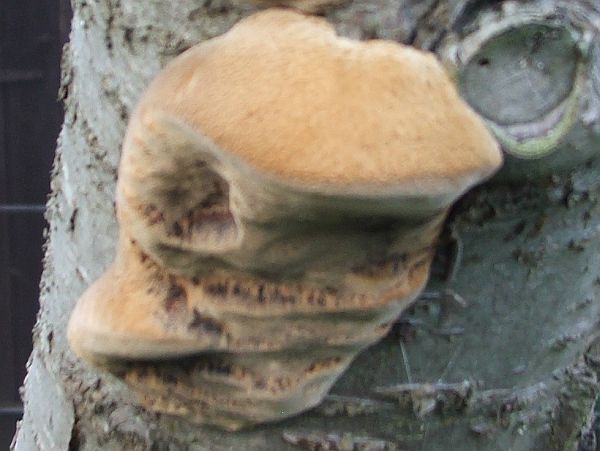Trees Birds Mammals Fish Amphibians Reptiles
Wild Algarve
Bookshop
Phellinus pomaceus (Pers.) Maire - Cushion Bracket
Phylum: Basidiomycota - Class: Agaricomycetes - Order: Polyporales - Family: Hymenochaetaceae
Distribution - Taxonomic History - Etymology - Identification - Culinary Notes - Reference Sources

Fortunately uncommon (but far from rare), this bracket fungus is a killer. Plum trees are the preferred victims of this very tough bracket fungus, which could be confused with Willow Bracket Fungus Phellinus igniarius.

Distribution
Phellinus pomaceus is an uncommon find in Britain and Ireland and rather variable in appearance depending on the age of the brackets and the particular species of host tree. (For example, on hawthorn it tends to be much darker in colour than when growing on plum trees.) Cushion Bracket also occurs in many countries on mainland Europe and in parts of Asia, and this species is recorded as native to North America.
Taxonomic history
In 1799 Christiaan Hendrik Persoon described this species, giving it the name Boletus pomaceus. It was the French mycologist René Maire (1878-1949) who, in 1933, transferred the Cusion Bracket fungus to the genus Phellinus, renaming it as Phellinus pomaceus, the scientific name by which it is generally recognised nowadays.
Etymology
In 1886 the genus Phellinus was circumscribed by French mycologist Lucien Quélet; the generic name comes from phell- meaning cork, while the suffix -inus denotes a superlative. The implication, therefore, is that fungi in the genus Phellinus are the most cork-like (the toughest) of them all. The specific epithet pomaceus comes from the Latin pomum and means of or relating to apples or fruit. Hence the Cushion Bracket's scientific name suggests that it is a very tough, cork-like fungus associated with apple trees. (It is in fact more often seen on Prunus species, in the UK.)
Identification guide
 |
Fruitbody
Cushion-shaped brackets, often tiered or overlapping and typically 10cm across. Upper surface finely felty, becoming smooth later; rufous or mid brown on young fruitbodies (see left), turning darker, sometimes purplish with age; outer margin sometimes remaining brown and felty even on old fruitbodies. Lower, fertile surface pale brown to cinnamon brown.
The tough, fibrous flesh inside these brackets is reddish brown. |
| |
Tubes and Pores
The shallow tubes are brown and spaced at typically 5 per mm; they terminate in grey-brown to cinnamon-brown pores. Basidia are clavate, 4-spored. |
| |
Spores
Subspherical, smooth, 4-5 x 3-4.5μm; inamyloid.
Spore print
White. |
Odour/taste |
Not significant. |
Habitat & Ecological role |
Parasitic and eventually saprobic, attacking broadleaf (hardwood) trees and most commonly plums, damsons and sloes (Prunus species) but also on hawthorn (Crataegus spp.) and apple (Malus spp.). It causes white rot of the heartwood. |
Season |
Perennial, long lived, releasing spores throughout summer and autumn. |
Similar species |
Fomes fomentarius is similarly hoof shaped with an overall grey appearance; it attacks mainly birches in Britain and Ireland.
Phellinus igniarius, another hoof-shaped bracket fungus, is found mainly on willow trees. |
Culinary Notes
Phellinus pomaceus is a tough, inedible fungus.
Reference Sources
Fascinated by Fungi, 2nd Edition, Pat O'Reilly 2016, reprinted by Coch-y-bonddu Books in 2022.
British Mycological Society (2010). English Names for Fungi
Dictionary of the Fungi; Paul M. Kirk, Paul F. Cannon, David W. Minter and J. A. Stalpers; CABI, 2008
Taxonomic history and synonym information on these pages is drawn from many sources but in particular from the British Mycological Society's GB Checklist of Fungi.
Acknowledgements
This page includes pictures kindly contributed by John Boulton.
Top of page...
Fascinated by Fungi. Back by popular demand, Pat O'Reilly's best-selling 450-page hardback book is available now. The latest second edition was republished with a sparkling new cover design in September 2022 by Coch-y-Bonddu Books. Full details and copies are available from the publisher's online bookshop...